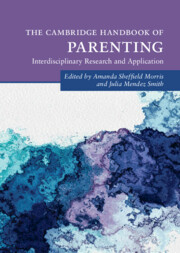Book contents
- The Cambridge Handbook of Parenting
- Cambridge Handbooks in Psychology
- The Cambridge Handbook of Parenting
- Copyright page
- Dedication
- Contents
- Contributors
- Figures
- Tables
- Introduction
- Part I Foundations of Parenting
- Part II Parenting across Development: Social, Emotional, and Cognitive Influences
- Part III Parental Factors That Impact Parenting
- Part IV Child Factors that Impact Parenting
- Part V Parent Education, Intervention and Policy
- 22 Parent and Family Engagement in Early Education Programs
- 23 Refugee Policies and Parenting in the United States and Germany
- 24 Parents as Earners: What Parental Work Means for Parenting and the Role of Public Policy
- 25 Parenting of Children Involved in the Child Welfare System
- 26 Technology and Parenting: Challenges and Opportunities
- 27 Preventing Risk Behaviors in Adolescence
- Index
- References
23 - Refugee Policies and Parenting in the United States and Germany
from Part V - Parent Education, Intervention and Policy
Published online by Cambridge University Press: 01 December 2022
- The Cambridge Handbook of Parenting
- Cambridge Handbooks in Psychology
- The Cambridge Handbook of Parenting
- Copyright page
- Dedication
- Contents
- Contributors
- Figures
- Tables
- Introduction
- Part I Foundations of Parenting
- Part II Parenting across Development: Social, Emotional, and Cognitive Influences
- Part III Parental Factors That Impact Parenting
- Part IV Child Factors that Impact Parenting
- Part V Parent Education, Intervention and Policy
- 22 Parent and Family Engagement in Early Education Programs
- 23 Refugee Policies and Parenting in the United States and Germany
- 24 Parents as Earners: What Parental Work Means for Parenting and the Role of Public Policy
- 25 Parenting of Children Involved in the Child Welfare System
- 26 Technology and Parenting: Challenges and Opportunities
- 27 Preventing Risk Behaviors in Adolescence
- Index
- References
Summary
In 2019, migration due to humanitarian crises has reached an unprecedented high with more than 272 million people not residing in their homes. As around 50 percent of recent refugees and immigrants worldwide were underaged, adverse experiences linked to migration hit them during critical periods of youth development. Strong families can provide resources to protect youth development amid seeking refuge and immigration. Specifically, effective parenting behavior was found to buffer the negative impact of adversity. In response to the increasing numbers of migrants and refugees worldwide, several receiving countries have modified their refugee policies, with consequences for the post-migration living circumstances of refugee and immigrant families. The purpose of this chapter is to discuss the impact of selected refugee policy domains (right to asylum, detention, family unification) on parenting behavior. We focus on the United States and Germany as the two Western countries with the largest populations of immigrants and refugees based on their population sizes. Although to different extents, both countries restricted their refugee policies since immigration has started to increase in 2015. Mechanisms through which refugee policies affect parenting include parent-child separation, hardship, access barriers to support services, experiences of community violence and demanding asylum policies. Apart from specific regulations for unaccompanied minors in Germany, children’s needs for positive development are left widely unattended in the current refugee policies of both countries. Interdisciplinary research needs to empirically substantiate cascading effects from refugee policies to family- and individual-level processes such as parenting and child development. A better understanding of these links can contribute to support immigrant and refugee families upon arrival, reduce emerging disparities and promote pluralistic societies of tomorrow.
- Type
- Chapter
- Information
- The Cambridge Handbook of Parenting , pp. 514 - 535Publisher: Cambridge University PressPrint publication year: 2022



